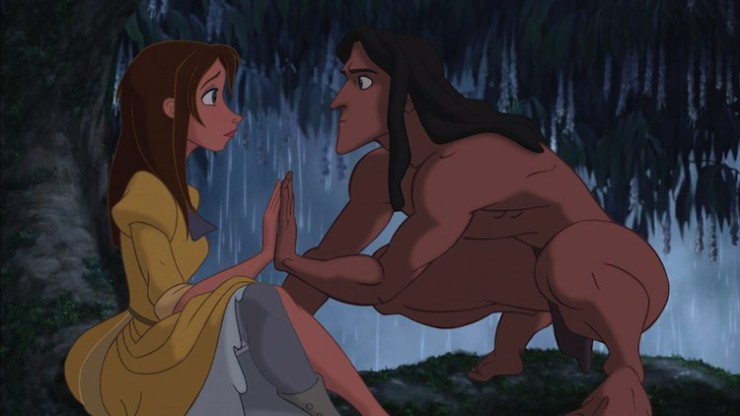“I’m in a tree with a man who talks to monkeys.”
As the 1990s drew to a close, the Disney Animation department faced a bit of a problem. The mid 1990s prestige films—Pocahontas, The Hunchback of Notre Dame, and Mulan—had done decently enough at the box office and award ceremonies, if more unevenly with critics, but somehow not quite as spectacularly well as the films that had started the Disney Renaissance—The Little Mermaid, Beauty and the Beast, Aladdin and The Lion King. By “spectacularly well” Disney and I both mean “toys and other merchandise sales.” Pocahontas and Mulan were to make inroads on this later, when their protagonists joined the Disney Princess franchise, but that was still a few years off. Disney needed something huge again. Something popular. Something that could fit in with the new Animal Kingdom theme park about to open at Walt Disney World in Florida.
They settled on Tarzan.
For Disney executives, Tarzan offered a number of immediate advantages: the character was a worldwide icon, and his early life was spent with animals who could easily be turned into cute toys. Indeed, Tarzan was so well known that Disney could more or less ignore the book (which, as we’ll see, they did) and instead just focus on that iconic image. Yet, although the iconic image was created more by films and television shows than by the Burroughs books, animators could and did argue that Tarzan had never been properly captured in live action: only animation could fully convey those sorts of movements. Plus, An animated Tarzan could also interact closely with animated gorillas without any fear of distressing the gorillas—or the humans. That made Tarzan stand out from the previous prestige films: Disney could argue that—unlike Hunchback of Notre Dame, which had gone years without really needing an animated treatment—that their Tarzan was needed.
And Tarzan needed to be needed, because however great the toy potential, and however well suited for Animal Kingdom, Tarzan was about to become the most expensive animated film Disney had ever made. Even accounting for inflation, it cost more than either Sleeping Beauty or Pinocchio had in their time—the two films that had come close to closing Disney Animation down altogether.
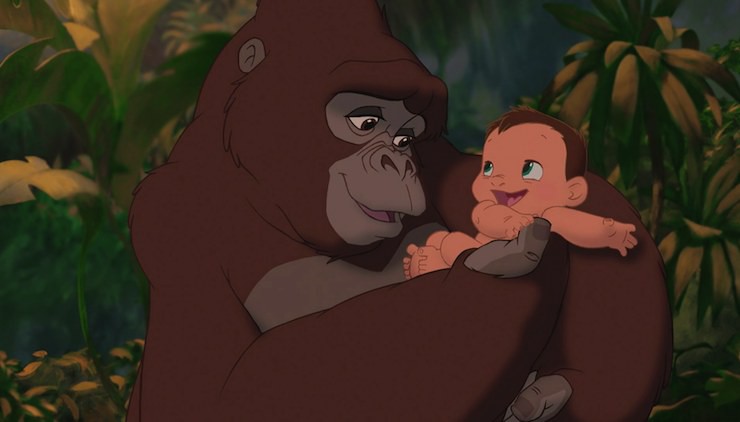
Disney had more money to play with these days. Still, they remained cautious, sticking with known quantities—such as Phil Collins, hired under the assumption that he would be sure to create a pop hit. That assumption turned out to be correct: “You’ll Be In My Heart,” (which appears twice in the film, sung by Glenn Close and Phil Collins, and then—in the version released as a single—by Phil Collins), landed as the number one song on Billboard’s Adult Contemporary list, and also won an Academy Award. Collins also agreed to record the songs in multiple languages, a Disney first.
To play Tarzan, Disney hired Tony Goldwin, then in his pre-Scandal days. For the now requisite Famous Comedian sidekick role, Disney hired Rosie O’Donnell (and then marginalized her far more than the other Famous Comedian sidekick roles). For the other roles, Disney stuck with their successful “name that voice” actor formula with Glenn Close, Minnie Driver, Brian Blessed and Nigel Hawthorne.
That just left animating Tarzan’s jungle world, and here, Disney tried something new: Deep Canvas, a 3D painting and rendering technique that won its creators an Academy Award for Technical Achievement. Deep Canvas allowed Disney animators to create a computer generated background that looked like a painting. This in turn allowed the camera to move around wildly—allowing Tarzan to do the same. This in turn allowed animator Glen Keane to go—er—wild with Tarzan; inspired by his son, who had recently taken up skateboarding, Keane decided to have Tarzan slide and skate across the trees—when not swinging on ropes. This all led to a gloriously happy ending where, above all, the characters look as if they are having fun, in part because they are moving in physical patterns viewers associate with pure recreation and sport.
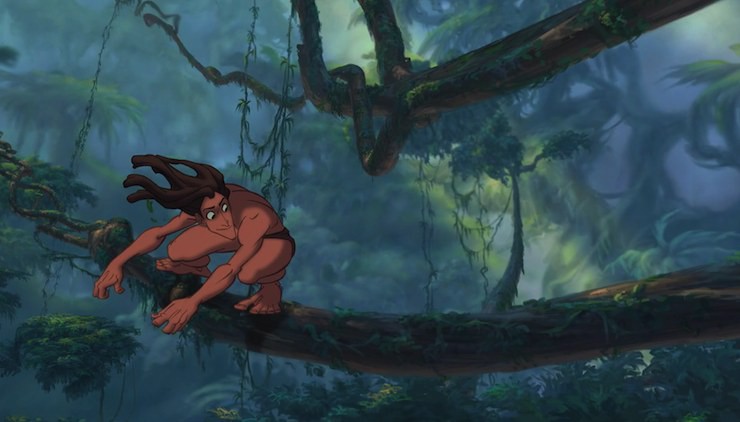
It also led to increased animation expense. To pull off the sliding across trees and the other Deep Canvas work, animators had to work unusually closely with the background artists and computer engineers, something made particularly tricky since this film was created by two different groups living in two very different places—Paris and Burbank. At one point, the entire animation team did get together to go look at animals in Kenya for a couple of weeks to make their gorillas look realistic, but otherwise, they needed phones and email. A lot of email.
If the animators did try for some realism with the gorillas (and to a much lesser degree the elephants, which were largely patterned after previous Disney elephants), they completely abandoned it in other bits of the film. And no, I’m not talking about the skating over trees here stuff, implausible though that is, or the moment when the gorillas and the elephant manage to create a nice little pop band from the equipment left by the scientists at their camp, but rather the moment when an elephant—an elephant—manages to swim across several meters of ocean water and then climb up on a ship. Fortunately this is played for comedy, but it almost puts the suspension of disbelief needed for the Tarzan novels to shame.
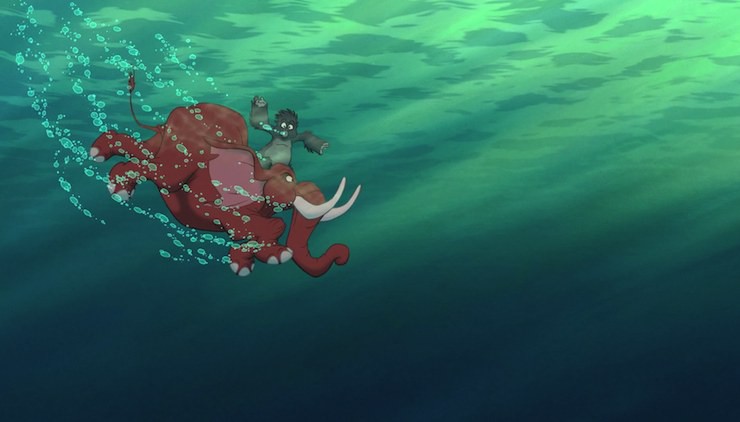
Not that the film was, as I’ve noted, particularly close to the original Burroughs novels or any of its sequels. As was now firm Disney tradition, several plot elements from the book were completely abandoned: Tarzan’s noble birth and position as the Earl of Greystoke; the scenes where Tarzan laboriously teaches himself to read; everything with the pirate gold (this is probably just as well); and Tarzan’s encounters with native African tribes (this is definitely just as well). Multiple characters were dropped, and others altered—Kerchek, the terrifying killer ape of the book that Tarzan needs to defeat was transformed into Kerchek, concerned if misguided leader ape that Tarzan needs to prove himself to. (Spoiler: it’s a Disney film, so yes, Tarzan succeeds, at an appropriate Sniffly Moment.)
But the biggest change occurs at the end of the film, when, instead of heading off to civilization and Jane, Tarzan instead chooses to stay in the jungle with the gorillas, accepting his new place as the head of a family. Jane, after a bit of hesitation, stays with him, and the film ends on a joyous note, with Tarzan and Jane—now stripped of her formal Victorian dress, wearing what looks like a much more fun short skirt and top—sliding merrily through the trees, followed by her father and the gorillas.
I’m a little uncertain about this. On the one hand, within the context of the story, it’s gratifying: Tarzan spent the first half of the film desperately trying to be a gorilla—so desperately that he endangered his gorilla family and forgot how to walk upright. And, during all of this, he was the underdog—weaker and different than his fellow gorillas, despised by the other young gorillas, who for the most part refuse to play with him. And the bit where Tarzan takes over the gorilla family is more or less from the book, so it’s even faithful to the source material. And Jane’s earlier awe of and delight in gorillas makes her decision to stay with them not just a decision to abandon her entire life for a guy, but to abandon her entire life for gorillas. I can buy that. And, well, it’s pure Disney, in keeping with the other films of the period: an outsider finally finding a place—and a home.
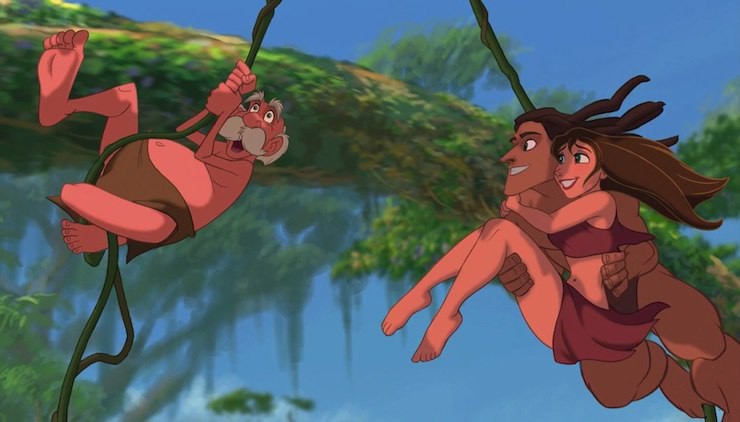
So why does that particular scene make me just a touch uncomfortable?
In part it might be because the gorillas are often mean to him—really mean. Even Tarzan’s best friend in the group, Terk, tries to abandon him more than once, and plays a trick on him that almost gets him—and a number of other gorillas and elephants—injured, if not killed. His mother lies to him. There’s good reason for all of this—Tarzan isn’t a gorilla—and to be fair, apart from Jane and her father, the first humans Tarzan encounters aren’t that much better. They spend their time either making fun of Tarzan, tricking Tarzan, yelling at Tarzan about gorillas, or throwing Tarzan into a shipboard jail, like, way to bring the wild guy back to humanity, guys, thanks, really. I can’t really blame Tarzan for turning his back on humanity after that—
Or maybe I can, partly because I did read the book, where Tarzan saw even worse behavior from various humans, and decided to head to civilization anyway.
But no, what bugs me here isn’t really Tarzan. It’s the gorillas. Because, let’s face it, the entire film is more or less about all of the problems Tarzan brings, mostly unintentionally, granted, to this poor gorilla family—from nearly getting the other gorillas and a couple of elephants injured in an earlier scene, to regularly abandoning them to go spend time with the humans, to later betraying their location to Clayton, leading to a scene where most of the gorillas end up captured and terrified, and one gorilla ends up dead.
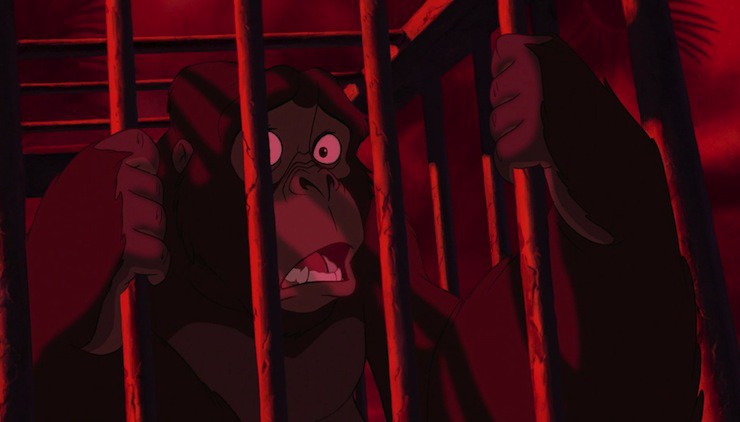
What I’m saying here, I guess, is that for all the joy in the film’s last few moments, and the sweet moments earlier, and sappy Phil Collins songs about being in your heart, I can’t help but think that maybe, just maybe, Tarzan and the apes really aren’t good for each other. And although yes, by the end of the film, the gorillas have learned to respect Tarzan, and Tarzan has learned to be an outstanding gorilla, something seems missing here. And that in turn makes me, as said, a touch uncomfortable.
The elephants, though, who are mostly sidelined in all this?
Are great.
Possibly because of the elephants, possibly because of the fun of watching Tarzan zip around the jungle, possibly because of the touching relationship between Tarzan and his adoptive mother, Kala, Tarzan was a financial success despite the film’s high cost. The Disney synergy machine moved into high motion, creating a short lived television show, a couple of sequels now available on DVD and Netflix, the Tarzan Rocks! show at Walt Disney World’s Animal Kingdom (later replaced by a Finding Nemo show), and a short lived Broadway show. Tarzan’s Treehouse took over the Swiss Family Robinson Treehouse at Disneyland, and became an attraction at Hong Kong Disneyland. The usual merchandise—clothing, mugs, toys—followed.
And yet, despite this merchandising effort and the film’s initial box office success, Tarzan, like the other Disney animated films of the late 1990s, slowly began to fade. Perhaps because Tarzan, like Hunchback of Notre Dame, didn’t feature a heroine who could—like Mulan and Pocahontas—be rolled into the Disney Princess line. Perhaps because, for all of his supposed wildness, Tarzan is one of the blandest of the Disney protagonists, who for the most part have been recognized for, well, blandness. Or perhaps because, however innovative its animation, Tarzan was, in the end, merely the latest in a line of 100 or so odd Tarzan films.
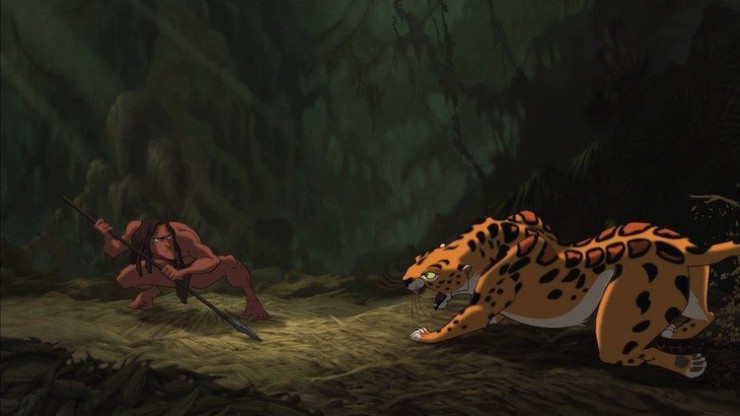
No one knew it at the time, but Tarzan marked the end of the so called Disney Renaissance—the films from The Little Mermaid onwards, credited with restoring the reputation and popularity of Disney animated films. It was a period of—Hercules aside—mostly ambitious films, featuring innovative animation, glorious art, serious subjects, and grand literary adaptations, and popular songs that became major hits and Disney staples.
With the exceptions of Lilo and Stitch and The Emperor’s New Groove, the later Disney films, as we’ll see, lost none of that ambition. But—with the exception again of Lilo and Stitch—for a decade and a half, none of them managed the same critical or financial success. Several, indeed, were box office disasters, and once again, Disney’s animation department faced the possibility of a permanent shutdown, especially thanks to the success of a few little films from a company called Pixar.
And on that rather depressing note, time to skip several films again since they are Disney originals not based on textual sources:
Fantasia 2000, the long delayed sequel to the original Fantasia film, was a critical success, but a box office failure. It has some marvelous bits, including a lovely piece set to Igor Stravinsky’s Firebird Suite that I highly recommend you check out if you haven’t already. This is probably the best animation Disney did between Tarzan and The Princess and the Frog, or arguably Tangled. Only one segment, however, “The Steadfast Tin Soldier,” is based on a literary source, so, skipping.
Dinosaur (2000) is not just a Disney original, but for several years, was not part of the official Disney Animated Classics series. Notable mostly for using live action footage as a backdrop to its computer generated animation, it performed well enough to inspired several changes to the dinosaur ride at Animal Kingdom in Walt Disney World. Otherwise, it had little impact on future Disney animation or Disney.
The Emperor’s New Groove (2000) was apparently originally based on the story “The Emperor’s New Clothes.” About the only thing the two stories have in common, however, is that their titles both include the word “Emperor.” Otherwise, this is a Disney original, notable mostly for its focus on comedy and a design that looked far more like the classic Warner Bros shorts than Disney. The film was profitable, but performed below box office expectations, sounding warning bells through the animation department.
Atlantis: The Lost Empire (2001). The producers claim this film, Disney’s second attempt at creating a PG animated feature, was “inspired by” Jules Verne. After watching the film, many viewers decided that it was “inspired by” the Indiana Jones films or Stargate: SG-1. Although it has since gained the status of a cult film, it initially performed poorly at the box office, and is often listed as the film that started the post-Renaissance Disney decline, except by those people who list The Emperor’s New Groove or Tarzan as the film that started the post-Renaissance Disney decline.
Lilo & Stitch (2002). If you’ve met me at a con, you may already know my feelings on Stitch: I have a Stitch backpack, a Stitch mug, and a couple of Stitch trading pins, mostly because I find it very comforting to carry around images of a creature of complete destruction who learns to love Elvis. Which is to say, Lilo & Stitch is one of my all time favorite Disney animated films, and it breaks my heart to have to leave it out of this Read-Watch, even if this does mean that Tor.com readers are spared a post mostly consisting of I LOVE STITCH I LOVE STITCH I LOVE STITCH oooh look at the watercolor backgrounds I LOVE STITCH which is to say, nobody is missing much.
Produced, like Mulan, at the Florida animation studio, the comparatively low-budget Lilo & Stitch was the one bright spot for Disney Animation between Tarzan and Tangled, launching a number of direct to video sequels, a television show, and a line of Stitch merchandise. It was bright enough to keep the animation studio from closing down completely, and enough to give them hope that their next boundary breaking film would be enough to regain the leading role in animation from Pixar.
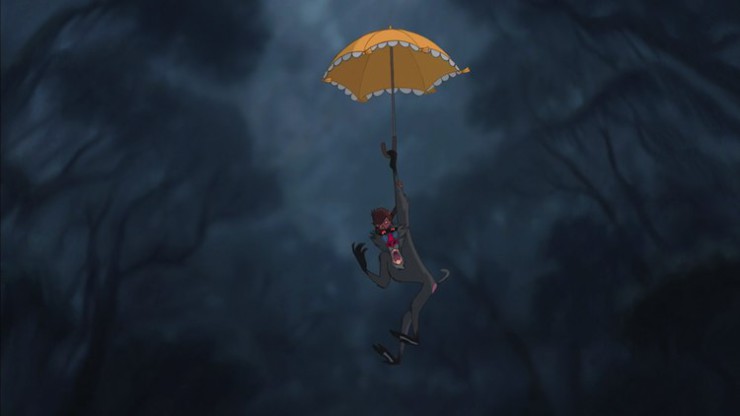
As I’ve said so many times before in these posts, we’ve all been very very wrong sometimes.
Next up: Treasure Island/Treasure Planet.
Mari Ness lives in central Florida.










